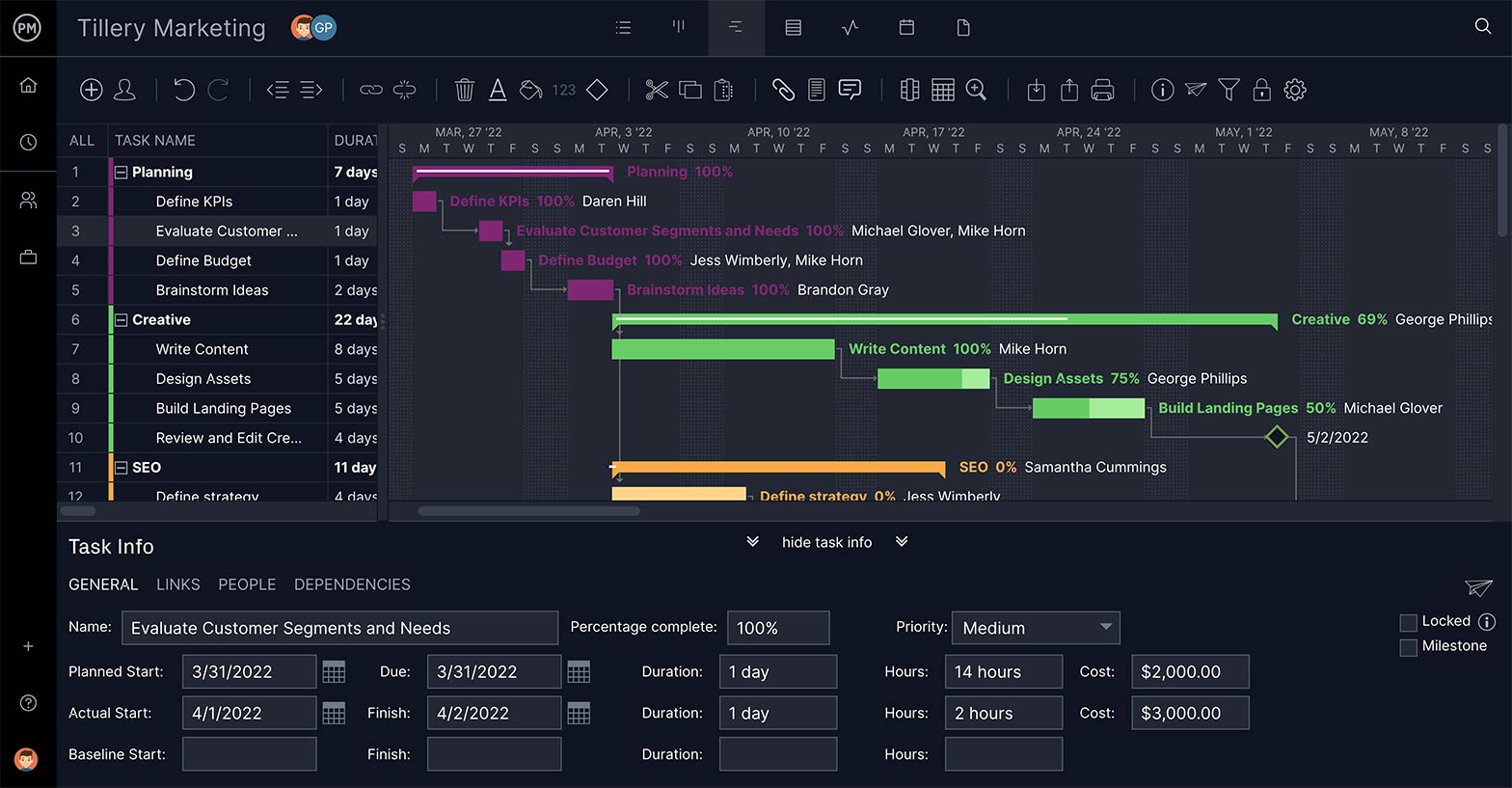- What Is a Product Plan?
- What Is Product Management?
- How to Make a Product Plan
- What Is Product Planning Software?
- Offline vs Online Product Planning Software
- Must-Have Features of Product Planning Software
- Product Roadmap: Definition & Example
- How to Make a Product Roadmap
- Product Market Fit: Ensuring Your Product is a Success
- The Product Launch: Secrets to Success
What Is a Product Plan?
Product planning, as the name implies, is all of the planning and strategy that goes into a product, from market research and design all the way through the product launch. It also includes ongoing improvements and changes to a product, so the process is never really completed.
Managing a project that ends in a product is like managing a product, but different. It follows much of the same course of action and activities that any project does, but products are unique. There are challenges that you need to know if you’re creating a product plan.
Managers find that using planning software to lay out their product plans increases the chance that their products will make it to market. ProjectManager has key features for product planning:

Key principles when creating a product plan include the following.
- Craft a product vision that fits a market need
- Initiate market research
- Foster communications between departments
- Create a product plan to achieve your goals
- Plan team sprints to execute in iterations
- Review and change plan throughout as needed
- Deliver a working product at launch
- Make a marketing plan for your product
Before we get to that, there’s a bit of background that is necessary. Let’s open wide with the big picture, then dig into product plans, roadmaps and successfully launching your product.
What Is Product Management?
Put simply, product management is a way to organize the planning, production, marketing and other tasks related to the creation and distribution of a product. It involves the coordination of teams, data, processes, business systems and more.
In reality, product management can be a complicated matter. There are a lot of moving parts in the creation of any product, regardless of its size. Without a methodology and proper tools to manage the many elements that must be tracked throughout the life cycle of the product, the risk of failure is greatly increased.
What Is the Objective of Product Management?
The main objective of product management is the development of a new product or products. This product should be better than what is currently available, or at least be able to differentiate itself as unique, in order to be of value for the customer.
What determines whether the product is profitable and successful is the customer’s reaction. While product management can vary in its function and the roles related to it, according to the size of the company, there is always a product manager to make certain that the objectives of the product are met. This can be a person or a group of people in the organization.
Product management doesn’t only add to meet the objectives of the product and organization; it can also choose to remove something from the process, which is called an elimination decision. This includes a detailed report on the impact that this elimination will have on the whole business.
How to Make a Product Plan
There have been a number of frameworks published over the years that explain how to do product planning, many of which are purely theoretical in their approach.
While the technical theory of product planning may interest some, we’ve found it more helpful to use an action-oriented method, which is outlined below.
1. Define a High-Level Product Vision
The product planning process begins with an idea. Most good ideas are born when a consumer notices a need for a specific product that will solve their problems. They then realize that they are not alone in this need; there are other people who could benefit from such a product.
Once you have your new product idea, the next step is to develop a high-level vision for the product that can be used to pitch it to potential consumers. This high-level vision should outline the following things.
- What your new product does
- What problem your new product solves
- Who specifically could benefit from using your product
- Why your new product is better than alternative solutions
While a product vision describes the essence of your product, it should be more than just that. A good product vision will be aspirational. It should motivate your teams to see this not merely as another job but a mission that fulfills an important need.
2. Execute a Customer Needs Assessment
The next step in the process is to bring your vision to potential customers via a needs assessment. This step is important to make sure your product is viable, meaning it could be helpful to other people. You need to make sure it’s not a wild idea that isn’t useful.
Begin by finding a group of people in your potential target market. The key is to contact a large group of people so that you get broad feedback. If your target group is too small, you may get limited feedback, which won’t be representative of the whole market.
Share your high-level pitch and ask for general feedback. If you receive positive feedback from certain people, make sure you take down their contact information. This way you can reach them once the product is built.
If you receive some negative feedback from your target audience, don’t be discouraged: you aren’t going to win over every person. However, if all of the feedback you receive is negative, then it may be time to go back to the drawing board for your product.
Take all of the feedback you get and put it into one central document. Here, you can quantify and qualify all of the information and pull out useful insights. Valuable information is buried in that feedback.
3. Do Market Research
Market research is about knowing your competitors and your unique place in the market. In doing market research, you are trying to identify weak points in the competition, which will create an opportunity for you to come into the market. Pay close attention to the following items when sizing up the competition.
- Who runs the competing company?
- How many employees do they have?
- Who are they targeting?
- How are they marketing to their audience?
- What are they doing well?
- What are they doing poorly?
4. Create a Minimum Viable Product (MVP)
An MVP is a version of the product that has all of the core properties and functions, but nothing more. The reason for using an MVP approach is simple: speed to market is important for success, and an MVP keeps you from getting into the weeds and staying there.
5. Gather User Testing and Feedback
The goal of this round of feedback is to identify and iron out any bugs or problems that users find, before you release the product to the public. Ask a lot of questions and record everything. You can take the recordings and have them transcribed so that you can quantify the results into useful graphs later. Use a change log template to collect this feedback and the changes you’ve made.
Once you are confident that your product is ready, you can release it to the world. It’s important to note that user testing is never really complete. It should be done on an ongoing basis for the lifetime of your product.
6. Create and Maintain a Product Roadmap
A product roadmap can help you organize all of the work that needs to be done for your product in the form of a helpful timeline structure. This is useful even after your product is launched.
Read on to learn how to create a product roadmap – but first, an introduction to some tools of the trade.
What Is Product Planning Software?
Product planning software is a tool that helps product managers and developers plan their projects on a timeline. It has features that store documents dealing with that project, such as project goals, and generally manage the product life cycle. Watch the video below to learn more about planning software.
Some of the tools that give product managers the control they need to deliver the product on time and within budget include a product roadmap and customizable boards, all within a software that is flexible enough to work in a variety of methodologies — from waterfall to an agile framework.
In order to stay on schedule and keep to your budget, most product planning software also has features that monitor and track your progress and performance after the planning stage and into the execution phase. To do this many offer a high-level view with dashboards and more detail in a number of reports. Microsoft Project is one of the most commonly used project management software, but it has major drawbacks that make ProjectManager a better choice for project planning.
Offline vs Online Product Planning Software
Using product planning software is the first step to taking control of your project. The next is deciding which type of software you buy. Before you think of a brand, you need to know if you want offline or online product planning software.
There are differences beyond connecting to the internet. For example, having desktop software usually means working with a faster tool. The simple reason is that online connections slow you down, even if you have fiber optics it’ll never be as fast as an offline software.
Another issue to take into consideration is security. While both offline and online tools promote secure data, it’s easier to lock up your information on a desktop. There are just fewer ways to access it. But that doesn’t mean desktops are the way to go, they have limitations.
The biggest setback you’ll find using an offline tool is that collaboration is difficult. If everyone is working in the same office, then you can network the computers, but buying a license for each of those terminals to use the software is going to get expensive.
Online tools tend to have subscription pay models to allow users to select the plan best for them. They also allow distributed teams to stay connected, which fosters collaboration and increases productivity. Managers get real-time data, which helps them make more informed decisions that further benefit the product.
Must-Have Features of Product Planning Software
If you choose to use online product planning software, then make sure it has these essential features.
Use online Gantt charts to track and visualize your schedule as it moves through its life cycle to launch. Create a product roadmap to define mission critical tasks, add due dates in a spreadsheet and then see those automatically represented in a color-coded timeline.

See your product backlog on the visual kanban board. Teams can use the tool to manage their sprint, with tagged cards that indicate the priority of the task and more. Managers get transparency into the process to add resources to match their team’s capacity.
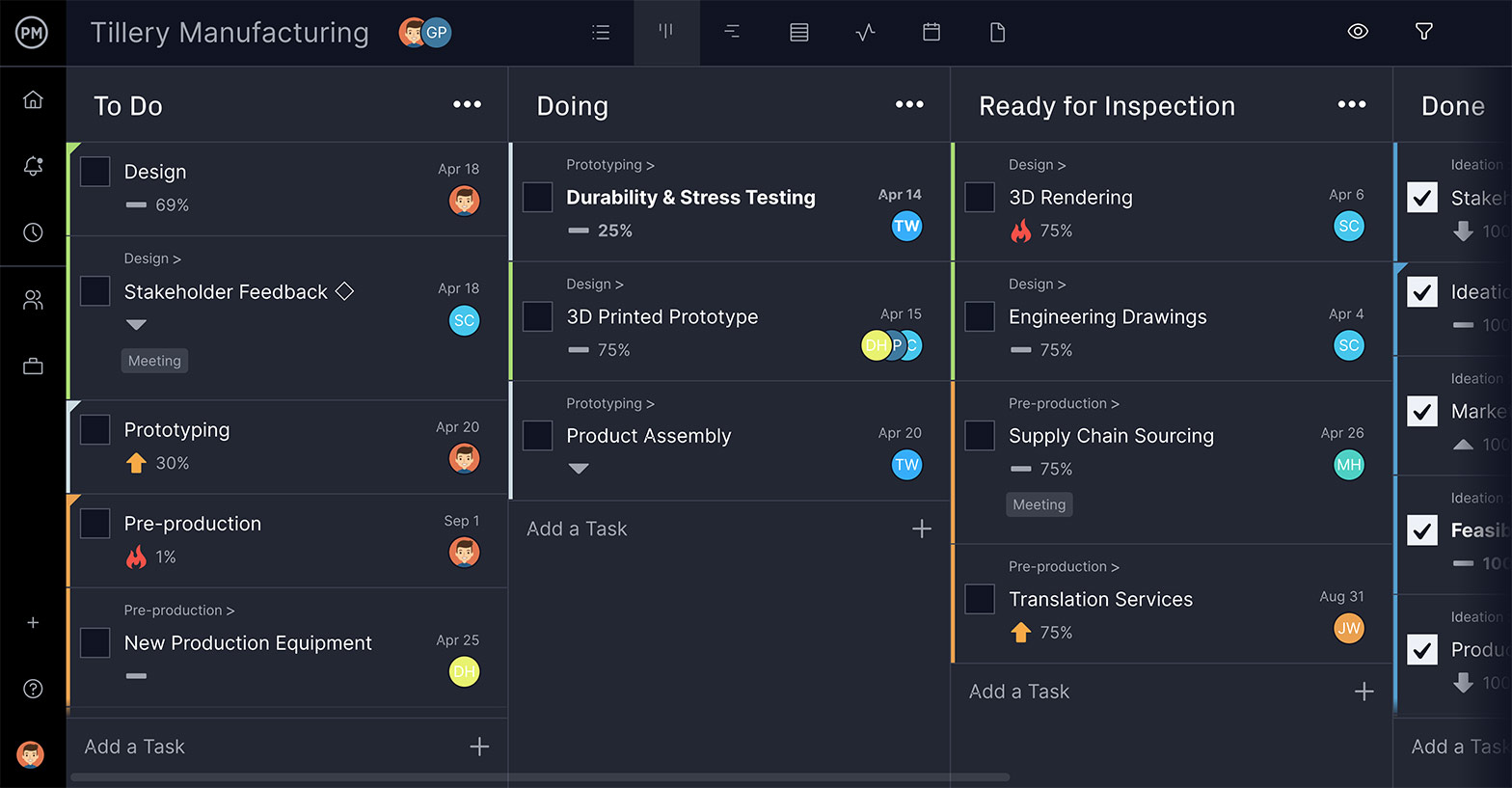
Execute tasks how you want with multiple project views. Use Gantt charts, kanban boards, task lists and calendars to manage your task. All data is shared across the software to allow teams to collaborate with other team members no matter which tool they’re using.
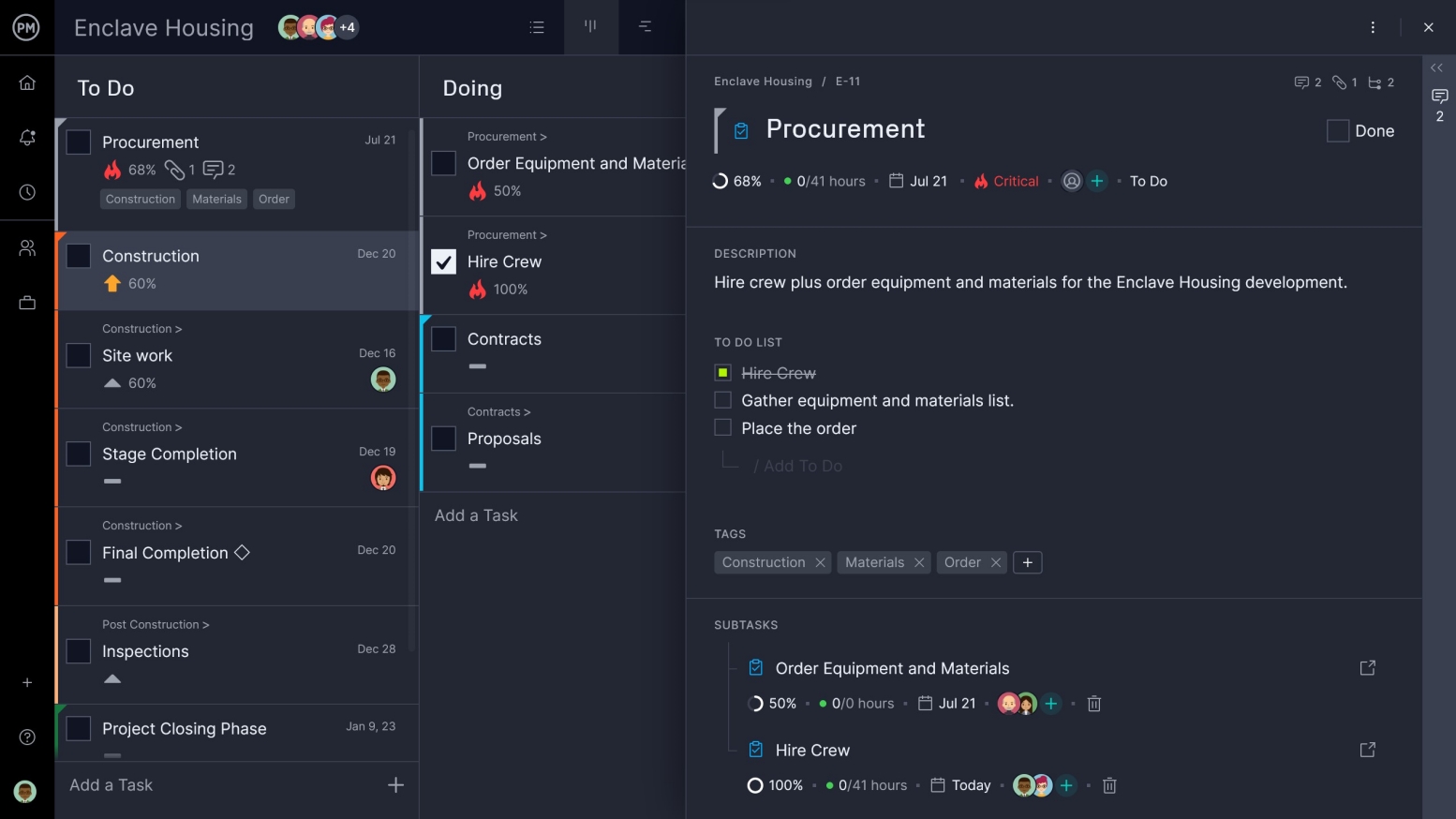
View your progress with a high-level dashboard, which captures project data and automatically calculates that information and displays it in various graphs and charts. Keep track of metrics on time spent on tasks, costs, workload and many others.

Monitor your team’s workload and availability so that you can schedule ahead and give each team member the right amount of work. You need to see your team’s tasks to know who is over-assigned or under-assigned, and then easily reallocated to keep them productive.
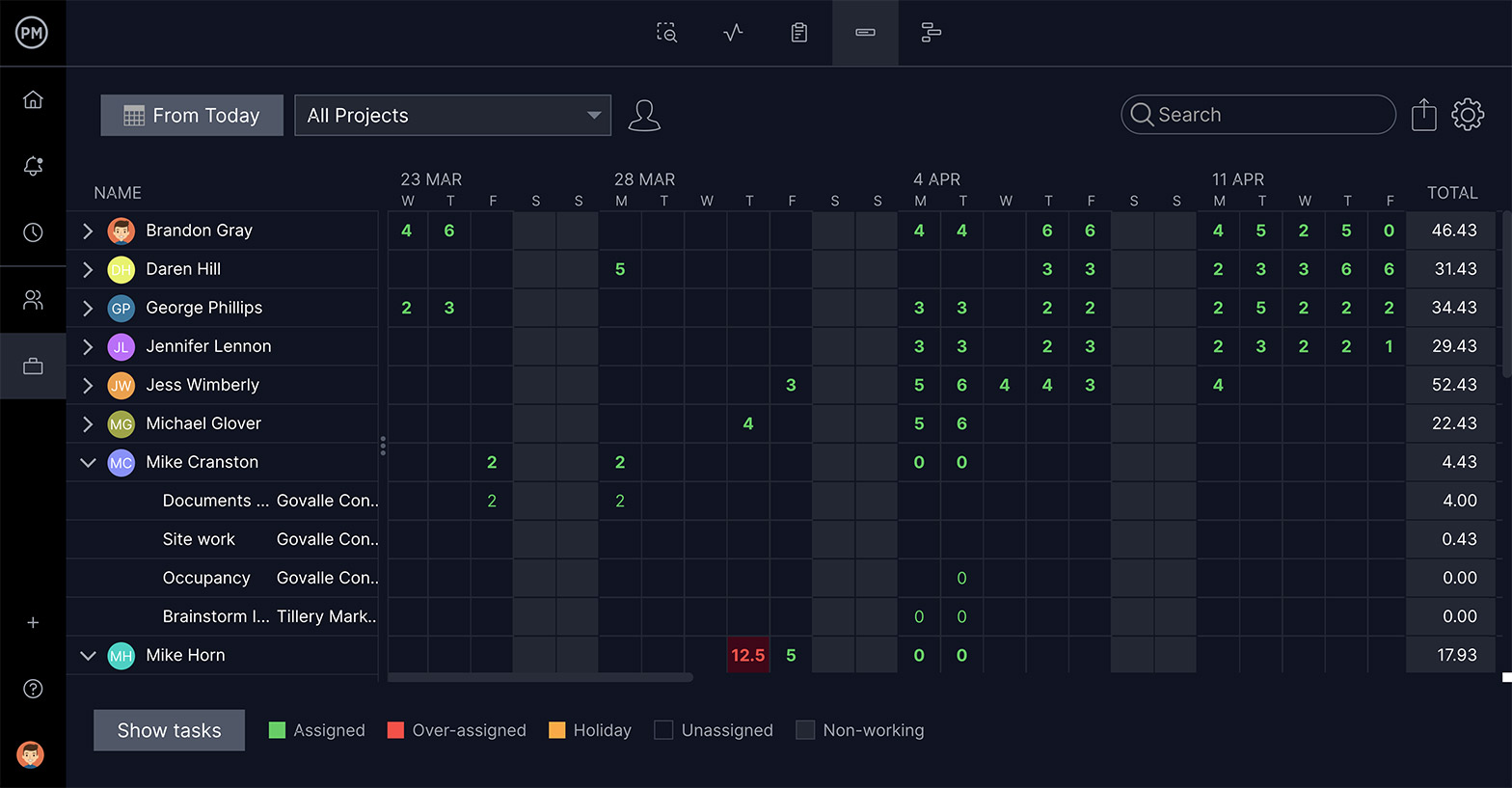
Manage the project for your product or a portfolio of products with tools that help you see synergies to work more efficiently. Get dashboards that are designed for monitoring metrics across many projects and a roadmap that shows you all your products on one timeline.
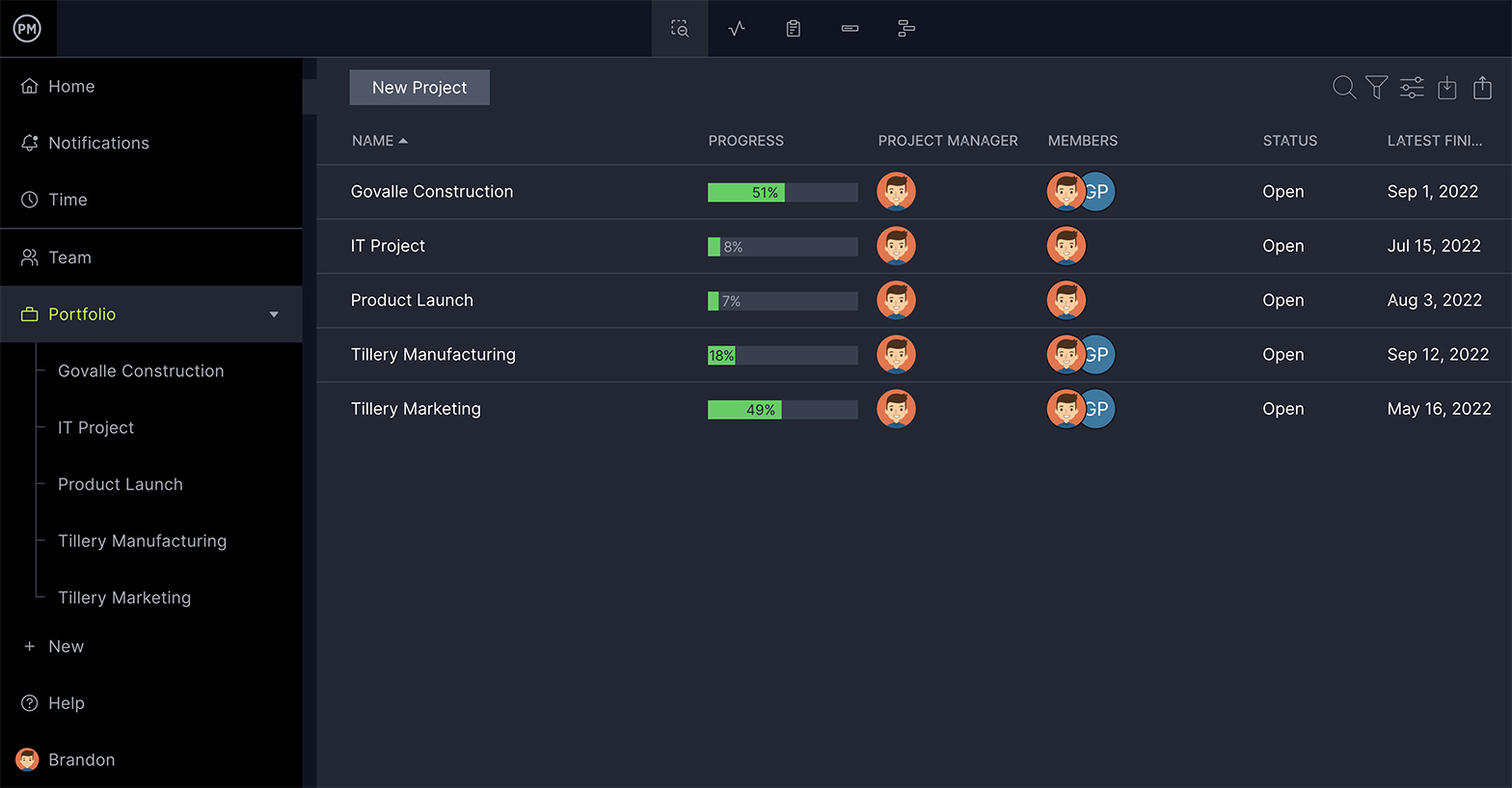
Product Roadmap: Definition & Example
A product roadmap is essential to product management because it allows the product manager, and anyone involved in the project, to see the big picture.
What Is a Product Roadmap?
A product roadmap is a bird’s-eye view of the vision and direction of a product over time. What a product roadmap captures is the vision and strategy of the product, and it serves as a guide for executing that strategy. It’s all laid out in such a way for it to be easily understood by everyone in the product group.
The product roadmap is the responsibility of the product manager, both to create and to use as a communication tool. This sets the proper expectations, while sharing the product overview and highlighting important parts to come.
The great importance of the product roadmap is that it speaks to everyone from stakeholders to team members on a high-level. Therefore, it must be clear, easy to understand and communicate critical details.
Because a product roadmap must be clear and simple, it can’t be cluttered with too much detail that will distract from the overall strategy and implementation. Therefore, a product roadmap is not a product plan. It might share elements of a product plan, but not at such a granular level.
Key Elements of a Product Roadmap
- Measurable Goals and Objectives: Goals are the high-level statements that give a larger context to the product in terms of what it’s trying to achieve. Objectives are more specific and result in tangible deliverables.
- Collaboration and Communication: There are likely many teams that are working together to create the product. Therefore, the product roadmap must facilitate clear communication of the overall strategy of the product and keep everyone on the same page.
- Align with Corporate Objectives: The high-level view of a product roadmap is designed to dovetail with the overall objectives of the corporation to make sure the product is aligned with where the company is going.
- Leave Time to Learn and Research: This graphic view of the schedule, which is laid out from left to right, must also include whatever research and learning curve is needed to make sure everyone on the product team is knowledgeable about what they’re doing and how they’re doing it.
Why Use a Product Roadmap?
A product roadmap is a great tool to make sure that everyone knows what the product is about, how it will be executed and who is doing what. Those are just a few of the benefits, here are more.
Fast Communication
The product roadmap is a great way to quickly communicate the product strategy and goals at a high level and with a visual clarity that makes it easy to understand for everyone. This includes managing the expectations of stakeholders as well as communicating with all other important parties.
Keeps It Grounded
As constraints and variables occur, the product roadmap keeps your decision-making tethered to the goals and objectives of the product, so you can prioritize tasks and make decisions quickly and accurately.
The Challenges of Product Roadmaps
That doesn’t mean there aren’t challenges that product managers must be aware of when creating a product roadmap. If a product roadmap isn’t realistic, there can be delays, cost overruns or mismatched expectations later in the product.
If teams don’t share their progress, then the product roadmap can’t be accurately updated. A product roadmap should be updated regularly. The product roadmap shouldn’t be updated too frequently, however, as it’s a long-term goal document. Also, keep the goals realistic or they become too hard to handle.
Tools for Making a Product Roadmap
There are many tools that can help one create a product roadmap, from the simple to the more dynamic. Because the product roadmap is a visual tool, though, it’s not something that can be slapped together on a Word document or even a spreadsheet.
A Gantt chart is useful to display all the milestones of the product. The tasks will be points on the timeline with bars to indicate the duration of the tasks. If any tasks are dependent on one another, they can be linked. All of which offers a graphic and clear overview of the product.
How to Make a Product Roadmap
Gantt charts are a cornerstone feature of ProjectManager, an award-winning software that organizes products and teams to work more productively. Our cloud-based tool means product roadmaps are online and easy to convert and share.
It’s easy to build a product roadmap on our tool by following these steps.
List Milestones
Milestones are important dates, like deadlines or when certain documents or requirements are due. They typically reflect the end of one product phase and the start of the next one.
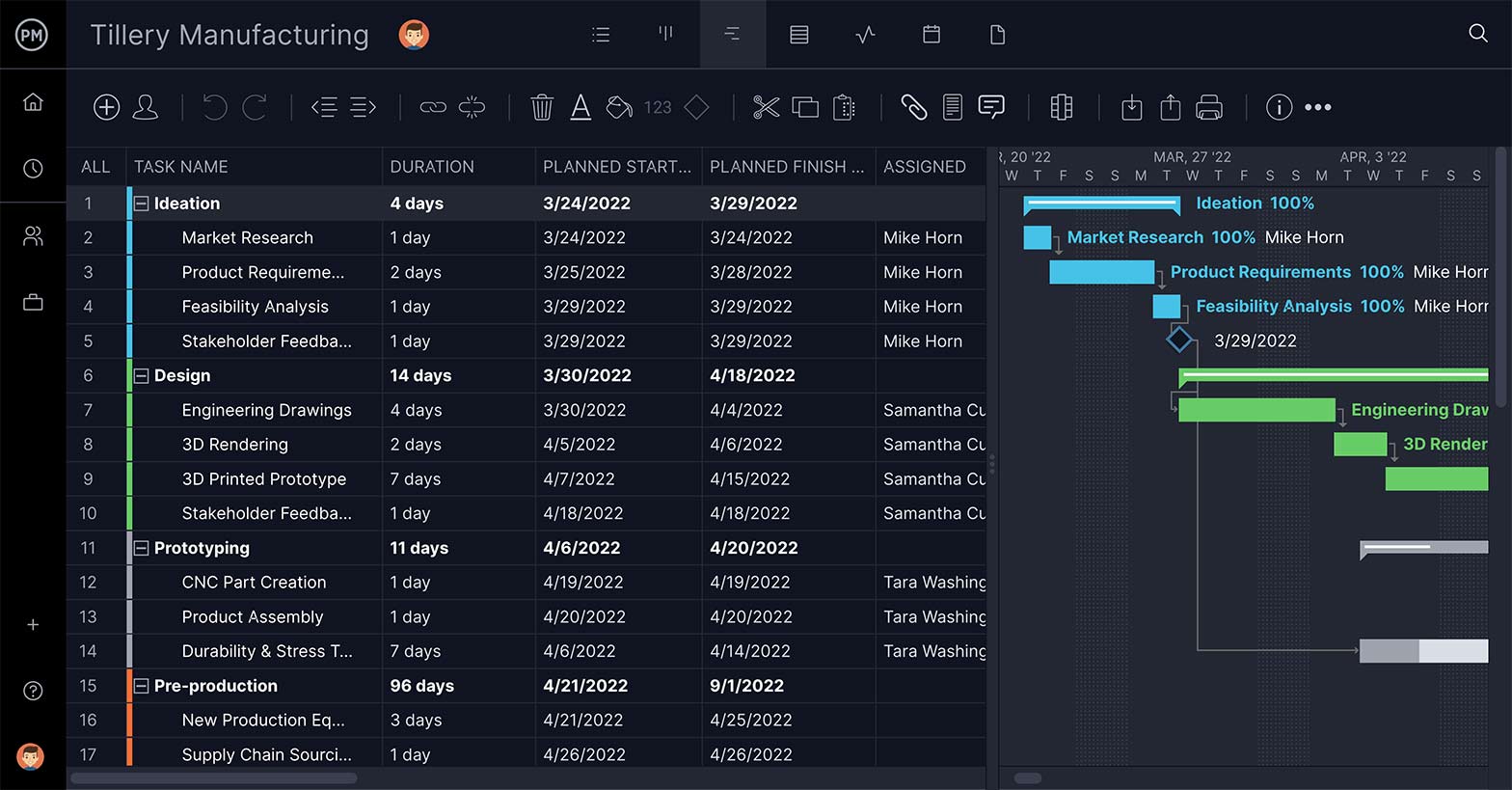
Set milestones on the Gantt roadmap and they’re indicated on the visual timeline by diamond-shaped icons. This is the first step to breaking up your product into feasible bits.
Link Dependencies
Dependent tasks are those that cannot start or end until another has started or ended. Identifying these avoids bottlenecks later on in your product execution phase.
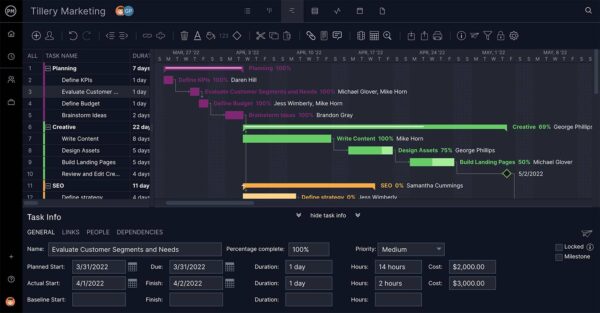
Connect dependent tasks on the Gantt roadmap by simply dragging one to the other. This can be done for all four types of dependencies and is indicated on the timeline by a dotted line.
Update Progress
Keeping your product on track and within budget requires monitoring and tracking its progress and performance so you can make necessary adjustments.
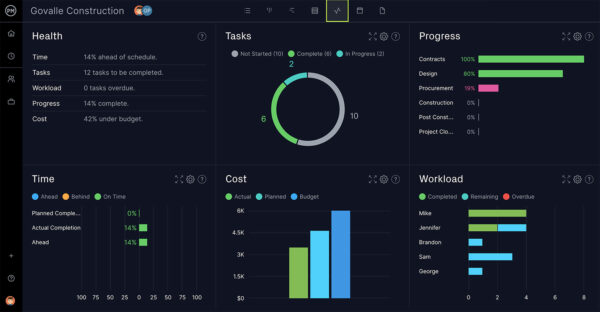
View high-level progress with our real-time dashboard, which captures metrics such as time, tasks, costs and more, automatically does the calculations and then displays them.
Update Stakeholders
Keeping your stakeholders updated on how the product is proceeding and that it’s staying on target as defined by the product plan is essential.
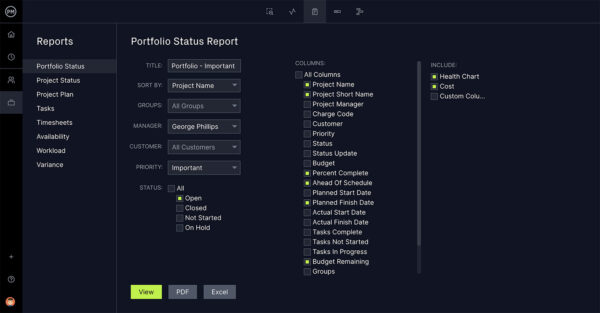
Know product details by using one-click reports on progress, costs and more. They can be filtered to show just what you need to see and then easily shared with stakeholders.
Product Market Fit: Ensuring Your Product is a Success
Marc Andreessen, the American entrepreneur, investor and software engineer, was the first to use the hyphenated phrase product-market fit. He said, “Product-market fit means being in a good market with a product that can satisfy that market.”
In other words, if there’s a demand for the product, the product will sell. Before there is a product, there must be a demand: it must fit in the marketplace. That’s the first step of smart product development. The idea of moving forward without thought to the end-user gets us back in the realm of art, which is not where we belong.
How to Find Product-Market Fit
The idea of a product-market fit is straightforward and even simple to define, but hard to achieve. There are stories of product-market fit successes that have become almost mythology. The obvious one is the Apple iPhone, a device that wasn’t unique but captured the imagination of customers so effectively that it’s hard to believe it was only introduced in 2007.
So, how can you discern what the market demand is, and the product customers want, even if they don’t know it yet? Back to Olsen, who has created a process to establish a product-market fit. He has developed a six-step framework, which he called the Lead Product Process.
1. Know Your Target Customer
A good way to determine your target customer is by first taking the temperature of the marketplace and seeing what’s hot with a feasibility study. There is likely a group of people who want something badly that is not available. Their needs are not being met by the current market.
2. Find Underserved Customer Needs
You’ve got your target, now what are their needs that are not being met? There are sure to be definite needs that are going to lead to market opportunity. The needs of the customer that are not being presently met in the marketplace is potentially of great value if you can serve them by responding to it.
3. Identify the Value Proposition
When you know the value proposition, you have the seed from which to grow a successful product strategy. The value proposition explains the value your product can offer the customer and the ways in which it is original and alone in that offering, or at least better than the alternatives already available. The value proposition should go hand-in-hand with your mission statement.
4. Determine Minimum Viable Product Feature Set
You know the value proposition, and now you must make sure the product itself has what it needs to achieve that value proposition for the customer. But you don’t want to go overboard with too many features (use a product budget tracker to ensure you stay within budget.) It can be costly, but it might also obscure the real value of the product. Be elegant in your design and only add what your customer wants, just enough and not more. Your product manager and their team can iterate until they’ve reached that perfect balance.
5. Make Minimum Viable Product Prototype
You have the features, now to see if they work. A prototype is the product before you make the actual product, which will be mass produced. It allows you to test the prototype and get feedback to finetune the product.
6. Test Minimum Viable Product with Customers
Take the prototype and test it with the target customer in the market. Get detailed feedback by surveying the customers. Use your market research to guide you or the team you have in place to do the survey. But go deeper and do one-on-one interviews with each customer who has tested the product.
The Product Launch: Secrets to Success
The product launch is one of the most crucial processes in any successful project. You can do all the research and have stacks of market studies in hand that state how in demand your product would be once available, but if you don’t have a path forward to exploit that market opportunity, then you’ve failed.
To avoid failure, plan a product launch that accounts for the customer’s needs and wants, the competitive environment and the nature of the market. These steps can help you fulfill the goal of the project by releasing a successful product in the marketplace.
Parting Tips for a Successful Product Launch
The plan for a successful project launch should be developed in tandem with the project plan. You want to have done the due diligence in order to launch your product properly.
Define Target Audience for the Product
Does your product have an audience who needs or wants what you’re about to produce? Without a market, the product will wither and die, no matter how well you make it.
How to Reach Your Audience
Once you know who you’re selling the product to, next comes figuring out how you can get your message to them. That includes through advertising of course, but also by tapping into their way of thinking and tailoring your message to address their mindset.
What Problem Does Your Product Solve?
Part of reaching your audience is knowing how your product is solving a problem they’re having. Once you have that information, you can use it to focus all your marketing material.
Know the Buying Process
The foundation of all your marketing and sales rests on a deep understanding of the buying process. What, for example, are the buyer’s pain points? Where do they get their information, and who are the people or places that are influencing their purchases?
Create an Online Space for Your Product
It goes without saying that any product should be accessible online in some fashion. First, make sure you own the domain name for the product and have established an identity for it on all social platforms that pertain to your customers.
Make Sure Your Product Is Salable
Pitch the product, create advanced advertising, launch a website with an opportunity for customers to reserve the product when it’s available, and see who bites. If no one does, then reevaluate your product. But if they do, then you know your planning is well-founded.
Who’s the Competition and How Do You Differentiate Yourself?
Chances are you’re not the only business trying to exploit an opportunity in the marketplace. Who is your competition? Find them and learn everything you can about them. They will have weaknesses that you can take advantage of.
Create a Free Trial
Depending on the price of your product, the cost could be a hurdle for customers. To show them how essential your product is to resolving their problem or need, provide a free trial or demo for them to test drive the product, if possible.
Develop a Strategic Plan
A strategic plan should include figuring out the right product, testing your assumptions about the marketplace to make sure the product is viable and taking steps to acquire the customers who want the product. This requires gaining feedback from those customers, testing your plan before your official launch, practicing the launch itself and making a risk assessment of what might go wrong and how to respond.
Make Sure Departments Work Together
Once you have a strategic plan, it must be communicated clearly to everyone in the organization. Make sure that they’re focused on providing the customer with the best experience possible.
What’s Your Brand Voice?
When launching a product into the marketplace you want to have a singular voice that speaks to your customers about the product, which includes the tone you’re using. Because the product will interface with the public on a variety of fronts, it’s critical that you develop a set of brand voice guidelines to make sure that wherever the message is coming from, the voice of the brand is consistent.
Test and Test Again
After you do all this hard work to hype the product, it better live up to customer expectations. To make sure, test the product. That is obvious, but what might not be as clear is that testing is a process. You don’t just test once and are done with it. Test after getting feedback from customers and updating the product. Test the product brutally; break it. Then pinpoint those weak links, strengthen them and test again.
Know Your Limitations
There is always something that you don’t know, but someone else does. Therefore, don’t let the entire product’s launch rest solely on your shoulders or even on your organization’s. If you need help with an aspect of the product launch, be that building ad materials or setting up customer service phone banks, hire freelancers or experts to do it correctly.
Know Your Product’s Story Inside Out
You’ve lived with the development of this product, from research to production, and when you launch there will be media, new customers, brands who might comarket with you, etc., and they’ll all have questions. You must know your pitch and be able to answer all questions that might come up when delivering it. The product inspired you to initiate the project for its creation, and that inspiration must be contiguous and clearly rendered across all channels.
Get Started on the New One
You’ve got a product on the market, but that doesn’t mean you can sit back and reap the rewards. You must be proactive and start on the plan for the next version of the product. Again, this involves customer feedback, responding to mistakes in the initial iteration, etc. By being responsive, you’ll polish your brand and retain customer loyalty.
Creating a product plan and launching the product is another project. You need the right tools to create the product and launch it into the marketplace. ProjectManager is a cloud-based project management software with a real-time dashboard to track your progress and online Gantt charts that help you roadmap and schedule between departments and the market. Try it free today with this 30-day trial.
Start your free 30-day trial
Deliver faster, collaborate better, innovate more effectively — without the high prices and months-long implementation and extensive training required by other products.
Start free trial